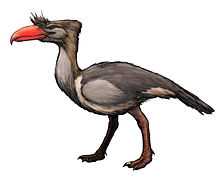Kelenken
| Kelenken Temporal range: 15Ma Early Miocene | |
|---|---|
 | |
| Restoration | |
| Scientific classification | |
| Kingdom: | Animalia |
| Phylum: | Chordata |
| Class: | Aves |
| Order: | Cariamiformes |
| Family: | Phorusrhacidae |
| Genus: | Kelenken Bertelli et al., 2007 |
| Species: | K. guillermoi |
| Binomial name | |
| Kelenken guillermoi Bertelli et al., 2007 | |
Kelenken guillermoi is an giant flightless predatory bird of the extinct family Phorusrhacidae or "terror birds".

K. guillermoi lived in the Langhian stage of the Miocene, some 15 million years ago, in Argentina along with Argentavis. With a skull 28 inches (71 cm) long (including its 18 inch, 45.7 cm beak), it had the largest head of any known bird. It is the largest species of phorusrhacid. The tarsometatarsus was about 45 cm long.[1]
Diet
It is not entirely clear how Kelenken captured and killed its prey. As a large flightless carnivore, Kelenken likely chased down and killed its prey with several bone-shattering blows from its massive beak. Another possibility is that it may have picked up its prey item, then proceeded to shake it vigorously in order break its back. It is also possible that Kelenken may have been a scavenger, driving off other predators from their kills with its impressive size.
References
- ↑ Bertelli, S.; Chiappe, L. M.; Tambussi, C. (2007). "A new phorusrhacid (Aves: Cariamae) from the middle Miocene of Patagonia, Argentina". Journal of Vertebrate Paleontology 27 (2): 409. doi:10.1671/0272-4634(2007)27[409:ANPACF]2.0.CO;2.